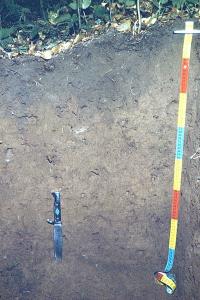Reference soil France 03: Cambisol
Cambisols occur mainly in the temperate and boreal regions of the world, where the soil’s parent material is still young or where low temperatures slow down the processes of soil formation.
Characteristics
Soils having either a cambic horizon (a horizon showing evidence of alteration with respect to the underlying material), or a mollic horizon overlying a subsoil, which has a base saturation of less than 50 percent in some part within 100 cm from the soil surface, or one of the following diagnostic horizons within the specified depth: an andic, vertic, or vitric horizon starting between 25 and 100 cm; a (petro-)plinthic or salic horizon starting between 50 and 100 cm, in absence of loamy sand or coarser textures above these horizons.
Reference soil FR003: Cambisols
Field pH-method is pH(H2O). PARENT MATERIAL: "Gres Vosgien" (Carte Geologique 1:80000, feuille 85, Epinal; 2nd edition 1939). VEGETATION AND LAND USE: Planting trees: 4 years ago. Species: Pseudotsuga Douglasii, Fagus sylvatica. ADDITIONAL NOTES ON PROFILE DESCRIPTION: O1 - mainly beech leaves. Ah - pH(KCl)=2.9 . - slightly brittle. AB - pH(KCl)=4.0 . - peds massive inside. Bw - pH(KCl)=4.2 . - peds massive within. - size pedotubules (root channels): fine. - size stones: 2-3 cm, some to 10 cm. C1 - boulders: red arkose. C2 - pH(KCl)=4.0 . - contains a highly micaous sandy clay layer at 130 cm; C3 - increasing amount of arkose fragments ("gaize").
